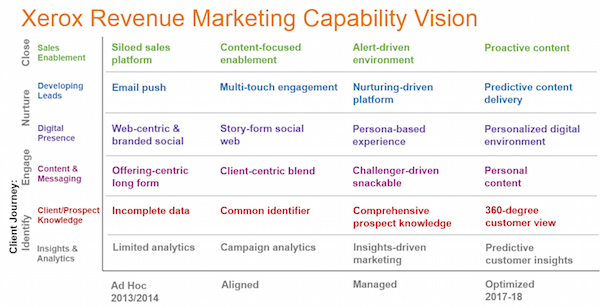Marketing technology management can look straightforward on paper, when analysts and pundit-bloggers such as myself draw simplified diagrams of new organizational structures with a few quick brushstrokes.
But the real work of implementing these organizational changes for “the new marketing” — and the cultural shifts entangled in that mission — especially at a major Fortune 500 company is considerably more complicated. I have tremendous respect for the people tackling that.
Therefore, it was my pleasure to be able to interview Mayur Gupta, the Global Head of Marketing Technology at Kimberly-Clark, to glimpse behind the curtain of that transformation in his organization.
Tell us a little about your background and what your role as Global Director, Marketing Technology at Kimberly-Clark entails.
I’m a marketing technologist who is part creative, part strategist, and part technologist. I recently joined Kimberly-Clark in August 2012 as the Global Head, Marketing Technology, a role that sits and fits within the CMO’s world and the global marketing organization.
It’s a bit difficult to pen down any role in marketing because it almost has to evolve at the pace of everything happening around us. But as we speak at this very moment, it involves curating, identifying, and establishing an agile marketing technology mindset, behavior, and a global culture — to not only execute but innovate our brand strategies.
“This group almost operates as a ‘change agent’ within our organization.”
I intend to do this through a Marketing Technology Group (MTG) that works very closely with our IT organization. I am part of a Digital & Relationship Center of Excellence (DRCOE), which is packed with some incredible leaders across digital strategy, creative, commerce, and now marketing technology. This group almost operates as a “change agent” within our organization. I see the MTG defining the global vision, and blueprint to enable our brands’ strategies and eventually deliver that most desired and relevant consumer experience.
Prior to joining KC, I pretty much spent most of my career at SapientNitro. The first few years there, I did everything from being a core Java developer to being a DBA, Unix administrator, and solutions architect. However, the last 7-8 years have been completely focused on digital marketing and marketing technology. From architecting and engineering a multi-channel integrated marketing automation and ad serving platform and running an innovation and digital production studio to playing a more thought leadership and marketing technology strategist role for a number of Fortune 500 clients.
How has it been making the transition from an agency to a dedicated role on the client side — especially around marketing technology? What did you expect? What has surprised you?
Interesting would be an understatement. I think it’s more empowering in a lot of ways. Working on the services side in a leading agency, you are are more or less guided by certain boundaries or parameters. At times these are financial constraints from clients and sometimes very specific business challenges or priorities.
On the client side, it’s a white canvas, which is a challenge — and an even bigger opportunity — especially if you’re working in the evolving and rather chaotic space of marketing in a digital world. I don’t think I went in with any kind of expectations. I went in like a sponge ready to absorb with a very open mindset.
I have been pleasantly surprised though with the agility and the spirit to adopt and adjust to changes for a big organization like ours. I think we are pretty uniquely positioned in the way we have the DRCOE as an “idea engineering” layer that drives changes and strategic thinking, helping to mould the new norms and conventions.
“It is a gradual mindset shift, an effort to strike a balance between [IT and marketing technology].”
I give a lot of credit to our leadership overall, specifically in the marketing organization, to have the foresight a few years back to establish an “agency” of sorts within a bigger organization. It is an effort to bring digital strategy, creative and consumer experience, e-commerce and marketing technology together — something that a lot of agencies still struggle to adopt.
There is a long road ahead, especially the emergence of marketing technology within a pretty strong and widespread IT footprint. It is a gradual mindset shift, an effort to strike a balance between the rigor, process and focus on standardization, scale and globalization of an IT organization and the need for agility, nimbleness, and innovation of marketing technology to deliver excellence for our consumers.
What do you think the relationship should be between a marketing technology group that lives within the marketing department and the IT department? How has that been playing out in your organization?
This is where it gets really interesting. Firstly, I don’t think we can draw a firm line that puts the Marketing Technology Group (MTG) in the marketing organization. I totally believe that it needs to exist, but where it lives, is very dependent on the organization, its leaders, and their mindset and culture.
The more important aspect is the recognition of evolution from a more conventional IT world. In my mind, an MTG can never replace IT. I see the MTG as a more strategic, innovative, and pretty lean layer. IT, on the other hand, is a more robust and scalable layer focusing on delivery and execution. One cannot replace the other. It’s collaboration vs. competition.
An analogy that I use is the process of building a tall, multi-story building. There is a crucial role played by the architect to create the “blueprint.” This is the role of a marketing technologist. But arguably a more important role is played by the actual builder — the IT organization — with a large team to transform the dream into reality. Irrespective of where the architect and the builder live, same organization or different, as long as they collaborate and understand each other, the building won’t collapse.
“Both IT and marketing leadership are working very closely together to lay down the foundation for marketing in a digital world.”
This journey at KC has been inspiring. We are in an evolutionary phase where both IT and marketing leadership are working very closely together to lay down the foundation for marketing in a digital world. It’s a conscious effort to strike a balance and avoid either extreme. Needless to say, such cultural and behavioral shifts are hard to adopt, but we are on the right path and moving ahead with lightening speed to bring the right changes.
How does your marketing technology team interface with the rest of the marketing department?
The MTG is still in its infancy to be honest, but the engagement model is fairly simple — basically drop all lines and be part of the team from inception to delivery. The key aspect is a belief that technology (marketing or information) is no longer a commodity. It is as strategic as digital strategy and as creative as anything else we design.
The MTG plays a more proactive role in defining technology strategy and vision, rather than a reactive one. The recipe for success is a tight collaboration and ideation across strategy, creative, and technology to deliver a consumer experience. That is how I see the MTG operating with rest of the marketing organization, as well as brands and our digital partners and agencies.
“The recipe for success is a tight collaboration and ideation across strategy, creative, and technology.”
From a technology perspective, what are some of the biggest challenges that you see marketing departments facing over the next year? How should they tackle them?
I personally feel that the well-known technical challenges, like big data or attribution and modeling, are easier to solve. There are enough really smart people out there that will solve these through technology. The challenges I see lie outside of the core technology.
The first is what I’d call “The Challenge of Too Many.” There are too many shiny disco balls out there. Difficult to say if this is a bubble, like the one we saw in the 90’s, but the marketing world is definitely seeing more movement and innovation than any other sector at this moment. I think many marketing organizations are sucking things in like a vacuum — a tendency to pick up every shiny object out there. Big data, mobile first, predictive modeling, and so on.
The challenge is a lack of a connected thinking that brings all these different pieces together in a cohesive and well-knit machinery. We all seem to be on the soccer field. It’s time for someone to go into the stands and have a top level view, to be able to orchestrate and position the right players to be at the right position at the right time.
“The challenge is a lack of connected thinking that brings all these different pieces together in a cohesive and well-knit machinery.”
Secondly, the diversity in the digital space is bliss, but if it does not move towards a more consolidated foundation, it will be a big challenge. I’d like to see the likes of Adobe, IBM, Oracle, and Salesforce come up with an open standard that allows marketers to focus on new and creative strategies and consumer experiences — and not worry about connecting 10 commoditized technology layers. A solid and standardized marketing operating systems — analogous to Android and iOS — with an open standard and framework to allow experiences through “apps” to be seamlessly installed.
Lastly, there’s a challenging in shifting mindset and behavior in the way we perceive and deliver technology. Adapting to the fast pace of the digital world, adopting agile marketing, believing that — at times — done is better than perfect. I mean these are interesting times for marketing technology and very easy to fall into the trap of thinking of technology as an end and not an enabler.
If you could offer 30 seconds of advice to other CMOs on marketing technology, what would you say?
It’s time to break free from the CMO-CIO barrier. Marketing technology demands a mindset, a behavioral and cultural shift, that goes beyond organizational boundaries.
“It is not a curriculum that’s taught, but an experience that’s gained.”
Unfortunately it is not a curriculum that’s taught, but an experience that’s gained through collaboration and a common vision towards impactful consumer experiences. The sooner you adopt it, the faster you will respond to the ever-changing digital and consumer landscape.
See first what others see eventually and don’t hesitate to fail.
Thank you, Mayur!




Well written – hiring a CEO who was once a CTO also helps the organizational challenge cited.
Great read! I’ve had the pleasure to work with Mayur at SapientNitro, and I can honestly say that he is probably one of the best people I have worked with. He has the ability to break down a project and solve it in ways that very few people can. Bottom line, one of the smartest people I know. Good luck on your next chapter my friend.
I also worked with Mayur at Sapient. His knowledge of the must-be marriage of technology and marketing is always demonstrated in his work and writings. Great interview.